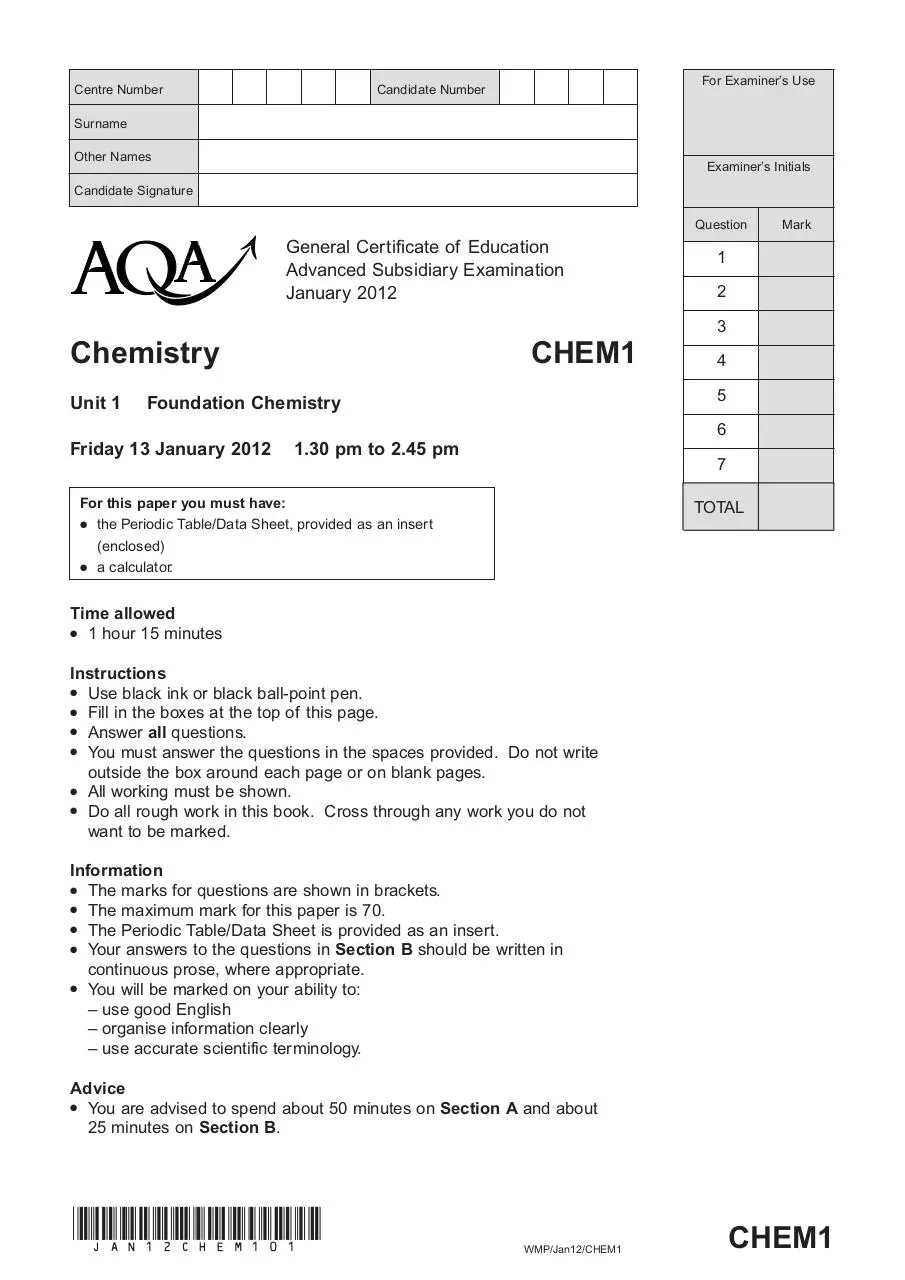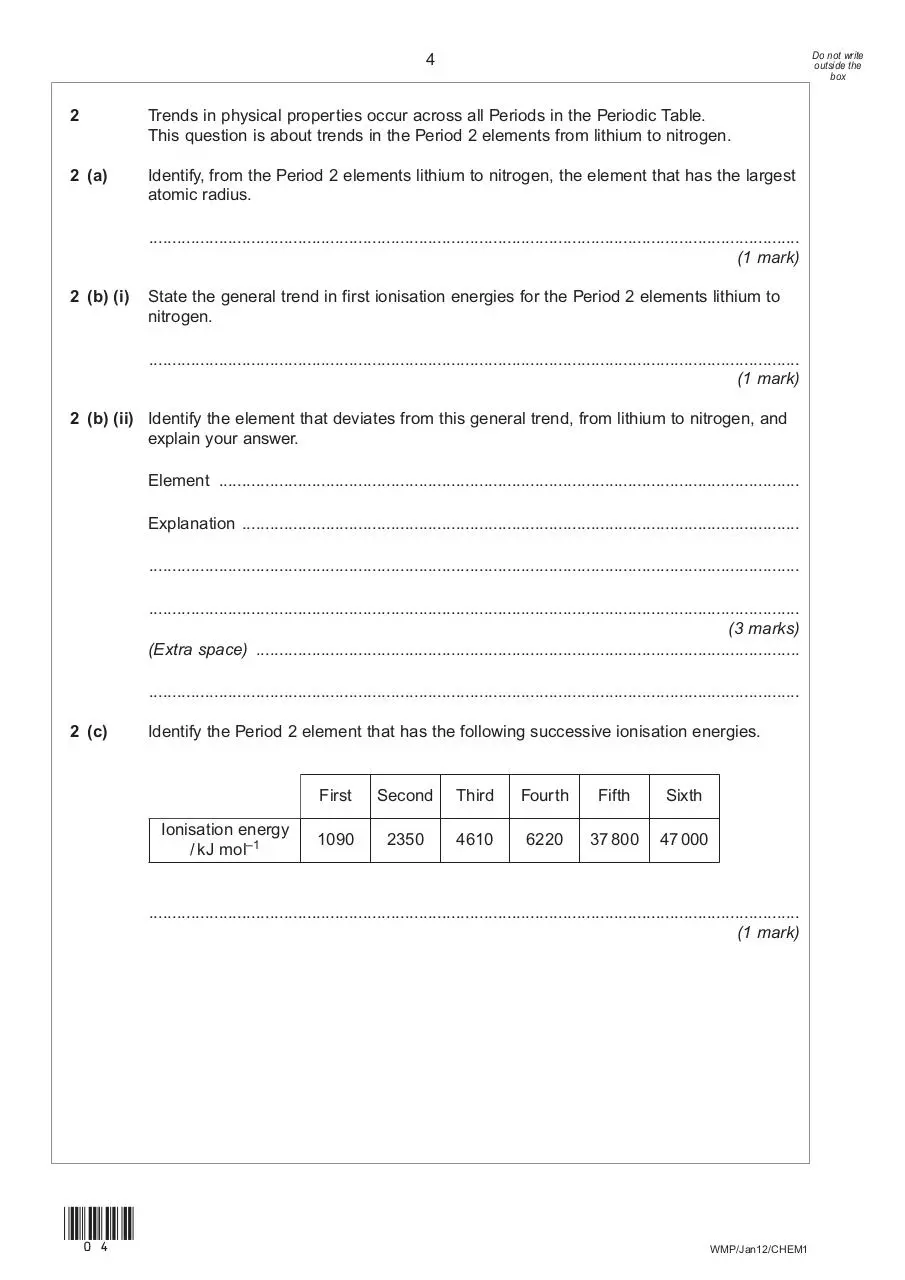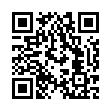AS Jan 12 (PDF)
File information
This PDF 1.6 document has been generated by , and has been sent on pdf-archive.com on 28/02/2017 at 16:02, from IP address 81.108.x.x.
The current document download page has been viewed 561 times.
File size: 1.27 MB (40 pages).
Privacy: public file





File preview
Centre Number
For Examiner’s Use
Candidate Number
Surname
Other Names
Examiner’s Initials
Candidate Signature
Question
General Certificate of Education
Advanced Subsidiary Examination
January 2012
Mark
1
2
3
Chemistry
Unit 1
CHEM1
4
5
Foundation Chemistry
6
Friday 13 January 2012
1.30 pm to 2.45 pm
7
For this paper you must have:
l the Periodic Table/Data Sheet, provided as an insert
(enclosed)
l a calculator.
TOTAL
Time allowed
l 1 hour 15 minutes
Instructions
l Use black ink or black ball-point pen.
l Fill in the boxes at the top of this page.
l Answer all questions.
l You must answer the questions in the spaces provided. Do not write
outside the box around each page or on blank pages.
l All working must be shown.
l Do all rough work in this book. Cross through any work you do not
want to be marked.
Information
l The marks for questions are shown in brackets.
l The maximum mark for this paper is 70.
l The Periodic Table/Data Sheet is provided as an insert.
l Your answers to the questions in Section B should be written in
continuous prose, where appropriate.
l You will be marked on your ability to:
– use good English
– organise information clearly
– use accurate scientific terminology.
Advice
l You are advised to spend about 50 minutes on Section A and about
25 minutes on Section B.
(JAN12CHEM101)
WMP/Jan12/CHEM1
CHEM1
Do not write
outside the
box
2
Section A
Answer all questions in the spaces provided.
1
Fluorine forms compounds with many other elements.
1 (a)
Fluorine reacts with bromine to form liquid bromine trifluoride (BrF3).
State the type of bond between Br and F in BrF3 and state how this bond is formed.
Type of bond .....................................................................................................................
How bond is formed ..........................................................................................................
............................................................................................................................................
(2 marks)
1 (b)
Two molecules of BrF3 react to form ions as shown by the following equation.
2BrF3
1 (b) (i)
→ BrF2+ + BrF4–
Draw the shape of BrF3 and predict its bond angle.
Include any lone pairs of electrons that influence the shape.
Shape of BrF3
Bond angle ........................................................................................................................
(2 marks)
1 (b) (ii) Draw the shape of BrF4– and predict its bond angle.
Include any lone pairs of electrons that influence the shape.
Shape of BrF4–
Bond angle ........................................................................................................................
(2 marks)
(02)
WMP/Jan12/CHEM1
Do not write
outside the
box
3
1 (c)
BrF4– ions are also formed when potassium fluoride dissolves in liquid BrF3 to form
KBrF4
Explain, in terms of bonding, why KBrF4 has a high melting point.
............................................................................................................................................
............................................................................................................................................
............................................................................................................................................
............................................................................................................................................
............................................................................................................................................
(3 marks)
(Extra space) .....................................................................................................................
............................................................................................................................................
1 (d)
Fluorine reacts with hydrogen to form hydrogen fluoride (HF).
1 (d) (i)
State the strongest type of intermolecular force between hydrogen fluoride molecules.
............................................................................................................................................
(1 mark)
1 (d) (ii) Draw a diagram to show how two molecules of hydrogen fluoride are attracted to each
other by the type of intermolecular force that you stated in part (d) (i). Include all
partial charges and all lone pairs of electrons in your diagram.
(3 marks)
1 (e)
The boiling points of fluorine and hydrogen fluoride are –188 oC and 19.5 oC respectively.
Explain, in terms of bonding, why the boiling point of fluorine is very low.
............................................................................................................................................
............................................................................................................................................
............................................................................................................................................
(2 marks)
(Extra space) .....................................................................................................................
............................................................................................................................................
15
Turn over
(03)
䊳
WMP/Jan12/CHEM1
Do not write
outside the
box
4
2
Trends in physical properties occur across all Periods in the Periodic Table.
This question is about trends in the Period 2 elements from lithium to nitrogen.
2 (a)
Identify, from the Period 2 elements lithium to nitrogen, the element that has the largest
atomic radius.
............................................................................................................................................
(1 mark)
2 (b) (i)
State the general trend in first ionisation energies for the Period 2 elements lithium to
nitrogen.
............................................................................................................................................
(1 mark)
2 (b) (ii) Identify the element that deviates from this general trend, from lithium to nitrogen, and
explain your answer.
Element .............................................................................................................................
Explanation ........................................................................................................................
............................................................................................................................................
............................................................................................................................................
(3 marks)
(Extra space) .....................................................................................................................
............................................................................................................................................
2 (c)
Identify the Period 2 element that has the following successive ionisation energies.
Ionisation energy
/ kJ mol–1
First
Second
Third
Fourth
Fifth
Sixth
1090
2350
4610
6220
37 800
47 000
............................................................................................................................................
(1 mark)
(04)
WMP/Jan12/CHEM1
Do not write
outside the
box
5
2 (d)
Draw a cross on the diagram to show the melting point of nitrogen.
5000
4500
X
4000
3500
3000
Melting point / K
X
2500
2000
1500
X
1000
500 X
0
Lithium
Beryllium
Boron
Carbon
Nitrogen
(1 mark)
2 (e)
Explain, in terms of structure and bonding, why the melting point of carbon is high.
............................................................................................................................................
............................................................................................................................................
............................................................................................................................................
............................................................................................................................................
............................................................................................................................................
(3 marks)
(Extra space) .....................................................................................................................
10
............................................................................................................................................
............................................................................................................................................
Turn over
(05)
䊳
WMP/Jan12/CHEM1
Do not write
outside the
box
6
3
Hexane (C6H14) is a member of the homologous series of alkanes.
3 (a) (i)
Name the raw material from which hexane is obtained.
............................................................................................................................................
(1 mark)
3 (a) (ii) Name the process used to obtain hexane from this raw material.
............................................................................................................................................
(1 mark)
3 (b)
C6H14 has structural isomers.
3 (b) (i)
Deduce the number of structural isomers with molecular formula C6H14
Write the number in this box.
(1 mark)
(Space for working)
3 (b) (ii) State one type of structural isomerism shown by the isomers of C6H14
............................................................................................................................................
(1 mark)
3 (c)
One molecule of an alkane X can be cracked to form one molecule of hexane and
two molecules of propene.
3 (c) (i)
Deduce the molecular formula of X.
............................................................................................................................................
............................................................................................................................................
(1 mark)
(06)
WMP/Jan12/CHEM1
Do not write
outside the
box
7
3 (c) (ii) State the type of cracking that produces a high percentage of alkenes. State the
conditions needed for this type of cracking.
Type of cracking ................................................................................................................
Conditions ..........................................................................................................................
............................................................................................................................................
(2 marks)
3 (c) (iii) Explain the main economic reason why alkanes are cracked.
............................................................................................................................................
............................................................................................................................................
(1 mark)
3 (d)
Hexane can react with chlorine under certain conditions as shown in the following
equation.
→ C6H13Cl + HCl
C6H14 + Cl2
3 (d) (i)
Both the products are hazardous. The organic product would be labelled ‘flammable’.
Suggest the most suitable hazard warning for the other product.
............................................................................................................................................
(1 mark)
3 (d) (ii) Calculate the percentage atom economy for the formation of C6H13Cl (Mr = 120.5) in
this reaction.
............................................................................................................................................
............................................................................................................................................
(1 mark)
3 (e)
A different chlorinated compound is shown below. Name this compound and state its
empirical formula.
CH3
H
CH3 Cl
C
C
C
H
H
CH3
Cl
Name .................................................................................................................................
Empirical formula ...............................................................................................................
(2 marks)
12
Turn over
(07)
䊳
WMP/Jan12/CHEM1
Do not write
outside the
box
8
4
Alkanes are used as fuels. A student burned some octane (C8H18) in air and found
that the combustion was incomplete.
4 (a) (i)
Write an equation for the incomplete combustion of octane to produce carbon
monoxide as the only carbon-containing product.
............................................................................................................................................
(1 mark)
4 (a) (ii) Suggest one reason why the combustion was incomplete.
............................................................................................................................................
............................................................................................................................................
(1 mark)
4 (b)
Catalytic converters are used to remove the toxic gases NO and CO that are produced
when alkane fuels are burned in petrol engines.
4 (b) (i)
Write an equation for a reaction between these two toxic gases that occurs in a
catalytic converter when these gases are removed.
............................................................................................................................................
(1 mark)
4 (b) (ii) Identify a metal used as a catalyst in a catalytic converter.
Suggest one reason, other than cost, why the catalyst is coated on a ceramic
honeycomb.
Metal ..................................................................................................................................
Reason ..............................................................................................................................
............................................................................................................................................
(2 marks)
(08)
WMP/Jan12/CHEM1
Do not write
outside the
box
9
4 (c)
If a sample of fuel for a power station is contaminated with an organic sulfur
compound, a toxic gas is formed by complete combustion of this sulfur compound.
4 (c) (i)
State one environmental problem that can be caused by the release of this gas.
...........................................................................................................................................
...........................................................................................................................................
(1 mark)
4 (c) (ii) Identify one substance that could be used to remove this gas.
Suggest one reason, other than cost, why this substance is used.
Substance ..........................................................................................................................
Reason why used ..............................................................................................................
............................................................................................................................................
(2 marks)
8
Turn over for the next question
Turn over
(09)
䊳
WMP/Jan12/CHEM1
Download AS Jan 12
AS Jan 12.pdf (PDF, 1.27 MB)
Download PDF
Share this file on social networks
Link to this page
Permanent link
Use the permanent link to the download page to share your document on Facebook, Twitter, LinkedIn, or directly with a contact by e-Mail, Messenger, Whatsapp, Line..
Short link
Use the short link to share your document on Twitter or by text message (SMS)
HTML Code
Copy the following HTML code to share your document on a Website or Blog
QR Code to this page

This file has been shared publicly by a user of PDF Archive.
Document ID: 0000561756.